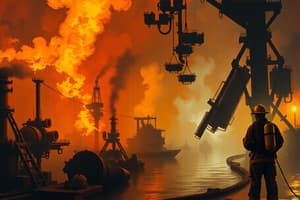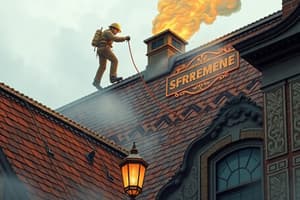Podcast
Questions and Answers
Tactical ventilation should be coordinated with an emphasis on:
Tactical ventilation should be coordinated with an emphasis on:
- Exposure protection
- Limiting personnel at the fire scene
- Controlling oxygen availability (correct)
- Controlling resources used
Firefighters use ventilation to control:
Firefighters use ventilation to control:
- Structural integrity of buildings
- The toxicity of products of combustion
- The amount of fuel available for the fire
- Where hot gases and smoke exhaust from a structure (correct)
The longer a structure or compartment is allowed to ventilate without water being applied, the sooner occurs:
The longer a structure or compartment is allowed to ventilate without water being applied, the sooner occurs:
- Intermittent improved fire conditions
- Transition to fuel-limited conditions
- Flashover (correct)
- Backdraft
Which is a condition specific to tactical ventilation that should be communicated to crew members and/or a supervisor?
Which is a condition specific to tactical ventilation that should be communicated to crew members and/or a supervisor?
Unplanned ventilation can significantly influence:
Unplanned ventilation can significantly influence:
Which is an indication of possible roof collapse?
Which is an indication of possible roof collapse?
Which tools would be used to open a ceiling after a ventilation hole has been made in the roof?
Which tools would be used to open a ceiling after a ventilation hole has been made in the roof?
Which type of ventilation consists of opening doors and windows to allow air currents and pressure differences to remove heat and smoke from a building?
Which type of ventilation consists of opening doors and windows to allow air currents and pressure differences to remove heat and smoke from a building?
Which type of ventilation is accomplished by using fans, blowers, or smoke ejectors to create negative or positive pressure?
Which type of ventilation is accomplished by using fans, blowers, or smoke ejectors to create negative or positive pressure?
What is the goal of positive-pressure ventilation (PPV)?
What is the goal of positive-pressure ventilation (PPV)?
Which type of ventilation requires that firefighters operating the nozzle remain in the heated, hazardous atmosphere throughout the operation?
Which type of ventilation requires that firefighters operating the nozzle remain in the heated, hazardous atmosphere throughout the operation?
Which is an example of vertical ventilation?
Which is an example of vertical ventilation?
When ventilation work on a roof is complete, personnel should:
When ventilation work on a roof is complete, personnel should:
Which inspection hole is the easiest and fastest to cut?
Which inspection hole is the easiest and fastest to cut?
When ventilating shingle-covered pitched roofs, always cut exhaust openings:
When ventilating shingle-covered pitched roofs, always cut exhaust openings:
Which type of fires are difficult to access without effective ventilation because firefighters would have to descend through intense rising heat and smoke to get to the seat of the fire?
Which type of fires are difficult to access without effective ventilation because firefighters would have to descend through intense rising heat and smoke to get to the seat of the fire?
Which type of ventilation is usually required for fires in windowless buildings?
Which type of ventilation is usually required for fires in windowless buildings?
Flashcards
Tactical Ventilation
Tactical Ventilation
The strategic control of oxygen availability during firefighting operations to enhance effectiveness.
Ventilation Coordination
Ventilation Coordination
Ensuring coordinated actions among firefighters to maintain safety, resource management, and exposure protection during ventilation.
Ventilation Purpose
Ventilation Purpose
The primary use of ventilation in firefighting; directing hot gases and smoke out of a structure.
Flashover
Flashover
Signup and view all the flashcards
Tactical Communication
Tactical Communication
Signup and view all the flashcards
Unplanned Ventilation
Unplanned Ventilation
Signup and view all the flashcards
Roof Collapse Indicators
Roof Collapse Indicators
Signup and view all the flashcards
Pike Pole
Pike Pole
Signup and view all the flashcards
Natural Horizontal Ventilation
Natural Horizontal Ventilation
Signup and view all the flashcards
Mechanical Ventilation
Mechanical Ventilation
Signup and view all the flashcards
Positive-Pressure Ventilation (PPV)
Positive-Pressure Ventilation (PPV)
Signup and view all the flashcards
Hydraulic Ventilation
Hydraulic Ventilation
Signup and view all the flashcards
Vertical Ventilation
Vertical Ventilation
Signup and view all the flashcards
Roof Evacuation Procedures
Roof Evacuation Procedures
Signup and view all the flashcards
Kerf Cut
Kerf Cut
Signup and view all the flashcards
Exhaust Openings on Pitched Roofs
Exhaust Openings on Pitched Roofs
Signup and view all the flashcards
Difficult Fire Access Cases
Difficult Fire Access Cases
Signup and view all the flashcards
Study Notes
Tactical Ventilation Coordination
- Tactical ventilation aims to control oxygen availability to enhance fire response effectiveness.
- Coordination is crucial for maintaining exposure protection, resource control, and personnel safety.
Ventilation Purpose
- Firefighters utilize ventilation primarily to direct where hot gases and smoke are expelled from a structure.
- Managing the structural integrity and toxicity of combustion products are also key considerations.
Flashover Condition
- Allowing a structure to ventilate without water application increases the risk of flashover.
- Quick response is essential to prevent the intensification of a fire.
Tactical Communication
- Key conditions for tactical ventilation like wind direction and strength should be effectively communicated among crew members.
- This ensures strategic planning and operational safety during fire response.
Influence of Unplanned Ventilation
- Unplanned ventilation significantly affects fire behavior in ventilation-limited fires.
- It can disrupt established control measures and exacerbate fire dynamics.
Roof Collapse Indicators
- Signs of potential roof collapse include melting asphalt and unusual smoke behaviors.
- Recognizing these indicators is vital for firefighter safety during operations.
Ceiling Opening Tools
- Pike poles are preferred tools for accessing and opening ceilings after creating roof ventilation openings.
- Their design allows for effective manipulation in tight spaces.
Natural Horizontal Ventilation
- Involves opening doors and windows to leverage air currents for heat and smoke removal.
- This method relies on natural pressure differences without mechanical assistance.
Mechanical Ventilation
- Achieved using fans or blowers to create positive or negative pressure, enhancing smoke and heat evacuation.
- Essential in scenarios where natural ventilation is insufficient.
Positive-Pressure Ventilation (PPV) Goal
- The primary goal of PPV is to increase interior pressure beyond that of the exterior structure.
- This method assists in smoke removal and creates safer conditions for firefighters.
Hydraulic Ventilation Characteristics
- Hydraulic ventilation requires firefighters to work in hazardous atmospheres while operating the nozzle.
- Essential for situations where smoke removal is critical but challenging due to heat.
Vertical Ventilation Examples
- Effective vertical ventilation methods include opening roof access points like scuttles or skylights for smoke eviction.
- These techniques allow smoke and heat to exit at higher points, improving conditions below.
Roof Evacuation Procedures
- After completing ventilation work on a roof, personnel should promptly evacuate for their safety.
- Monitoring ventilation conditions while on the roof is unacceptable after the job is done.
Inspection Hole Cuts
- The kerf cut is recognized as the easiest and fastest inspection hole to make during roof operations.
- Such cuts simplify access for further firefighting efforts.
Exhaust Openings on Pitched Roofs
- When ventilating pitched roofs covered with shingles, exhaust openings should be ideally placed at or near the highest part.
- This strategy optimizes smoke removal and helps control fire dynamics.
Difficult Fire Access Cases
- Basement fires present unique challenges, as firefighters must navigate intense heat and smoke to reach the fire source.
- Effective ventilation is crucial for accessing these hazardous environments safely.
Mechanical Ventilation for Windowless Fires
- Fires in windowless buildings typically require mechanical ventilation to facilitate effective heat and smoke removal.
- Understanding the need for various ventilation methods is critical for firefighting strategy in diverse building types.
Studying That Suits You
Use AI to generate personalized quizzes and flashcards to suit your learning preferences.




